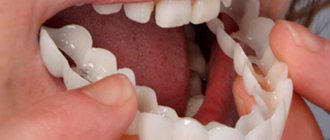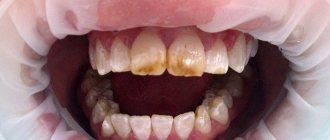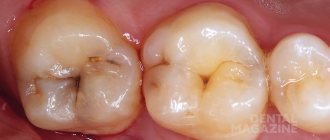- home
- Services
- Dental restoration for children
Baby teeth appear in a child from 6-9 months and are replaced by permanent teeth until the age of 12-14 years. Children's teeth, especially at an early age, are very vulnerable and susceptible to decay. It is careful attention to baby teeth that is the key to timely and correct growth of permanent dentition. A child with straight and beautiful teeth develops chewing and facial muscles correctly. Premature loss of even one baby tooth, untreated caries, crown injuries lead to the following problems:
- increased load on neighboring teeth;
- violation of growth order;
- deformations of the entire dentition;
- the occurrence of diction defects;
- deterioration of chewing function;
- aesthetic defects.
Changing the position of the rudiments of permanent teeth is a high risk of serious malocclusion, which is fraught with serious orthodontic treatment in the future. Natadent clinic specialists fight for every child’s tooth.
What is dental restoration
Restoration of baby teeth in children is carried out in the following cases:
- for damage caused by trauma;
- due to complicated caries.
Dental injuries in childhood are common. At the children's dental clinic "Natadent" we are ready to provide timely and qualified assistance. According to statistics, every third child suffers a tooth injury during sports games or vigorous activity.
By acting correctly, you can even save a knocked out tooth:
- Regardless of the severity of the injury, you should come for an examination to a pediatric dentist;
- take a photo to assess the nature of the damage;
- if displaced, the tooth must be strengthened by applying a splint or in another way at the discretion of the doctor;
- Deliver the child, along with the knocked out tooth, to the dentist’s office within 30 minutes.
Important! A knocked-out tooth cannot be picked up by the root, washed with water or treated with antiseptic solutions - this can make the process of its healing impossible and complicate restoration. It must be carefully taken by the crown and placed in saline solution, on the child’s cheek or in another biological environment.
If a piece of enamel breaks off from an injured tooth and dentin is exposed, then it cannot be left in this form. It is necessary to see a dentist and restore the damaged edge. Through a thin layer of dentin, pathogenic bacteria will enter the pulp and cause pulpitis. This can lead to tooth decay and costly treatment.
The Natadent clinic has all the possibilities for preserving teeth, restoring them and restoring them. We are sure that tooth injury is not a reason for losing it.
The need for restoration
The replacement of baby teeth begins at the age of five. They serve children up to a maximum of fourteen years of age, then they fall out and are replaced by permanent ones. They are not designed to be used for a long time. This variety has some features due to which they collapse faster than permanent ones.
These include:
- the layer of enamel in dairy milk is thinner than in permanent;
- the pulp chamber is closer to the surface;
- The dentin layer is also thinner.
Due to these features, caries develops faster in children. If it is not treated, pulpitis begins at lightning speed, and the coronal part is significantly destroyed. This process can take place without pain; the child gets to the doctor late. Most often he deletes this unit. Modern dentistry now makes it possible to restore almost completely destroyed crowns. Neither parents nor dentists consider it necessary to restore, let alone prosthetize, baby teeth for two reasons. The procedure is quite expensive, and there is no great need for it, since it is believed that the permanent ones will soon grow.
However, this must be done for the following reasons:
- if several units are missing, the child’s bite will not form correctly;
- improper redistribution of the load when chewing, they can shift and cover the eruption sites;
- in the absence of incisors, the child develops complexes because he is teased by his peers;
- the sharp edge of the destroyed unit injures the mucous membranes of the child’s oral cavity;
- in the absence, chewing of food is impaired, this threatens the development of gastritis and other digestive disorders;
- The baby may develop sound pronunciation defects.
It is imperative to treat caries in a child, as it can become permanent and contribute to the development of gum disease. However, the most dangerous consequence of losing baby teeth is the formation of a malocclusion.
Recovery methods
Several methods can be used to restore a child's teeth. The type of restoration is chosen by the dentist depending on the nature and degree of destruction.
The difficulty of a dentist’s work during the process of tooth restoration is that children quickly get tired due to the need to remain static in a chair. Therefore, the Natadent Children's Dental Clinic provides the possibility of dental treatment under local anesthesia, general anesthesia or inhalation sedation.
Sealing
If a tooth is partially damaged, the dentist evaluates the condition of the remaining hard tissues and the quality of the soft tissues around the crown and roots. The following filling options are possible:
- treatment of the canals of a baby tooth and placing a filling at the gum level so that the tooth is not in the bite and does not experience stress;
- restoration using filling material.
Light-curing composite materials have many advantages:
- the dentist can completely build up a child’s tooth and recreate the crown relief;
- the chewing surface becomes durable;
- there is no release of harmful substances into the child’s body;
- the material hardens under UV light;
- You can achieve a high cosmetic effect and the required degree of transparency of the filling.
To prevent the formation of cracks during the life of the child and during shrinkage, the dentist forms a filling when building up layer by layer. The composite has the ability to hermetically close any microcracks and firmly connect to dentin.
Light-composite materials are a real innovation in dentistry, with the help of which filling and restoration of teeth has become less traumatic and most effective.
Crown installation
Carrying out this procedure in children is surprising, but not among the specialists at the Natadent clinic.
It is recommended to use the following method:
- for large chips;
- with significant tooth destruction of 50% or more.
If the chewing surface and one of the side walls of the tooth are lost, the remaining thin walls will not withstand the chewing load for a long time.
Installing a crown is a reliable way to save a baby tooth from destruction and maintain its functionality until it is replaced with a permanent one.
Crowns help:
- chew food thoroughly, which is important for the vulnerable gastrointestinal tract system;
- prevent the appearance of persistent speech defects, which is especially important during the period of active development of the child and preparation for school;
- form the correct bite.
Timely protection of teeth with crowns is an opportunity to minimize further destruction of baby teeth, the development of secondary caries and prevent improper development of permanent teeth.
Natadent pediatric dentistry uses two types of crowns:
- ceramic for the front teeth, which do not differ from natural incisors in color and shape and do not violate the aesthetics of the smile;
- metal, made of stainless steel, which are the ideal solution for restoring the function of chewing teeth.
Modern crowns are high-quality products with a unique design; they do not require significant grinding of the tooth, but significantly prolong its life. At the clinics of the Natadent network, we restore teeth for children in the same aesthetic and beautiful way as for adults.
How restoration is done
The method in pediatric practice is chosen by the dentist. Its choice is determined by clinical feasibility. He is guided by the degree of destruction of the crown. The wishes and financial capabilities of the parents are then taken into account by him.
In what cases is each method used:
- a filling is placed if only one wall is destroyed;
- if two walls are missing, then it is carried out with depulpation;
- if three are missing, a crown is installed;
- in the absence of all the walls of the coronal part, and the roots are healthy, restoration is carried out using a crown and a reinforced structure.
Modern dentistry makes it possible to restore even almost completely damaged teeth.
Reviews
Your feedback is to help potential patients make the right choice. Leave your suggestions or comments so we can work even better.
LEAVE FEEDBACK
When do you need to restore baby teeth?
There are three main areas in the field of primary occlusion prosthetics:
- restoration, which is required if the aesthetics are compromised or a small part of the crown breaks off,
- restoration of the apex by installing a crown,
- complete restoration if the tooth was removed along with the root.
Restoration must be carried out. Firstly, for the sake of aesthetics - this is especially important if the child is at an age when the opinions of his peers greatly influence the child’s mood and psychological comfort. Secondly, to normalize nutrition and eliminate pathologies of the gastrointestinal tract. If even part of the teeth are missing, the child may chew food poorly, which will affect the digestive organs. And the third reason why prosthetics must be carried out is the protection of the entire jaw system.
If chewing is uneven (on one side), facial asymmetry may appear. If there are no teeth, the rest will begin to shift, so there will simply be no room left for the permanent ones. Another consequence is a violation of the position of the antagonists that are located on the opposite jaw. Due to the fact that they will not have support, they will move vertically, i.e. fall out of the hole.
Prosthetics and veneers
Young age is not an absolute contraindication for dental prosthetics. In practice, there are cases of successful installation of crowns and dentures in children under the age of one year. Unfortunately, this is often the only method that can help prevent tooth decay due to caries and other pathologies. You can install a crown on a tooth almost immediately after the unit has erupted.
Another restoration method is the production of microprostheses. This concept refers to the use of thin overlays on teeth, called veneers or lumineers. Microprostheses can be made of various materials: ceramics, porcelain, metal, composite, etc. Such onlays are highly durable compared to conventional fillings; they allow you to restore a tooth even if there is a large damaged area. It makes no sense to install such onlays on baby teeth; cheaper and simpler methods are suitable for this purpose.
There are strict age restrictions when installing veneers and lumineers. They are suitable for patients over 18 years of age, but in rare cases they can be used after 12 years of age. In any case, the final decision on the advisability of carrying out restoration and using a particular method is made by the attending physician.
previous post
Causes of damage to baby teeth
next entry
Sealing
Filling is the only method of artistic restoration of teeth that does not have any age restrictions. In this case, not only primary, but also dairy units should be subject to restoration. It is very important to restore all fissures, tubercles and irregularities on the teeth lost due to caries or injuries, because they are necessary for thoroughly chewing food.
Baby teeth can be restored using colored filling materials, which is very popular with young children. However, such fillings can only be installed on the surface of chewing teeth; they are not used in the smile area.
Of course, it can be very difficult for a small child to sit still for 30-60 minutes while the dentist is working. No more than one tooth can be restored at a time. In addition, most children are very afraid to visit doctors, so restoration has to be postponed for several years.
Types of damage and consequences of chips
Chip of tooth enamel or microcrack
As a result, the integrity of the upper dental layer is compromised, or its particles are separated. In most cases, such damage is barely noticeable and does not cause pain to the person; experts classify these defects as mild, and people prefer not to go to the dentist with such “nonsense.” However, places where the integrity of the enamel is damaged may be subject to various stresses, which provoke the development of pathogenic microflora, carious lesions and the activity of pathogenic microorganisms.
Vertical and horizontal cracks
Chipped tooth with dentin fracture
Considered to be a moderate injury. Such damage may not be accompanied by pain, or may cause discomfort and unpleasant sensations to external stimuli: hot or cold food, sour or sweet foods. Dentin is the inner tissue of the tooth and is inferior in strength to enamel, therefore, if the lost part is not built up in time, the dentin will begin to crumble, which can lead to tooth loss. From an aesthetic point of view, even a small chip in a front tooth can significantly reduce the attractiveness of your smile.
Deep fracture of the tooth to the pulp tissue with exposure of the nerve
This type of injury is considered the most severe, often accompanied by a split tooth into two parts, profuse bleeding and sharp pain, reminiscent of the torture of the Spanish Inquisition, and even painkillers only temporarily dull the pain. In such cases, delay can be fraught with inflammation and the development of infection.











